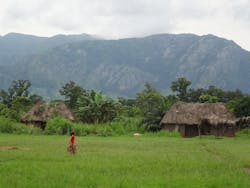New Agreement Promises to Accelerate Rural Minigrid Development in Nigeria
There has been considerable movement in the Nigerian minigrid landscape over the past several months.
This week, the Nigerian Rural Electrification Agency (REA), one of the key organizations responsible for driving much of that activity, announced it had signed a memorandum of understanding (MOU) with the Africa Mini-Grid Developers Association (AMDA) that is expected to accelerate the pace of minigrid development even more.
The MOU promises to build paths for knowledge sharing, build out minigrid capacity and improve coordination of the minigrid sector across the country.
“We are excited to partner with AMDA to further improve the development of minigrids in Nigeria while deepening the impact of REA solutions for socioeconomic growth. This MOU will further aid the accelerated deployment of minigrids and provide clean, sustainable and affordable electricity to more Nigerians,” said Ahmad Salihijo Ahmad, managing director and CEO of the REA.
Africa’s largest economy also has one of its largest energy gaps
With a gross domestic product of $477 billion, Nigeria’s economy is the largest in Africa, yet nearly 75% of the country’s rural population and nearly half of its total population have no access to reliable electricity.
Many remote communities, like Araromi-Okeodo, have never had access to the national electricity grid. They must rely on gas or diesel generators for their power, which can be expensive and, if fuel deliveries are delayed, unreliable.
Minigrids, sometimes referred to as remote microgrids, are considered an ideal energy solution for countries like Nigeria. Typically used in remote areas that do not have access to a central grid, minigrid systems use software to control distributed energy resources like solar panels and battery storage, providing remote communities with reliable, clean and affordable power.
In countries such as Nigeria, Tanzania, South Sudan and Ethiopia, minigrids are being used to electrify homes, businesses, streetlights and agricultural operations.
Minigrids are booming in Nigeria
In 2017, Microgrid Knowledge reported that minigrids in Nigeria represented a $9.2 billion market opportunity.
Fast forward to today and Nigeria is one of the largest minigrid markets in the world with over 100 minigrids now in operation.
Many of those installations were funded in part by the Nigerian Ministry of Power through the REA, and more are on the way.
The REA recently closed applications for grants from the Nigerian National Project, a minigrid program it is administering on behalf of the United Nations Development Program, Rocky Mountain Institute and the African Development Bank. The grants will help the REA fulfill its mission of increasing economic opportunities for unserved and underserved rural communities through its Energizing Agriculture Program.
Other players, such as the World Bank and Sholep Energy, are also active in the country. Husk Power alone has vowed to build 500 minigrids in Nigeria by 2026.
But despite the boon in activity, the REA said in a statement that “there is still a significant need for more decentralized energy interventions.”
REA and AMDA MOU will address the country's energy gap
The MOU between the REA and AMDA, which is a private sector industry association comprised of minigrid developers and operators, donors and investors, is expected to make a significant dent in Nigeria’s energy gap.
“Minigrids have the potential to transform the lives of millions of Nigerians, and this partnership is a step in the right direction. AMDA is committed to working with all stakeholders to create an enabling environment for the minigrid sector to scale and achieve sustainability,” said Lamidi Niyi-Afuye, CEO of AMDA.
Track news about minigrids in Africa. Subscribe to the free Microgrid Knowledge Newsletter.
About the Author
Kathy Hitchens
Special Projects Editor
I work as a writer and special projects editor for Microgrid Knowledge. I have over 30 years of writing experience, working with a variety of companies in the renewable energy, electric vehicle and utility sector, as well as those in the entertainment, education, and financial industries. I have a BFA in Media Arts from the University of Arizona and a MBA from the University of Denver.

